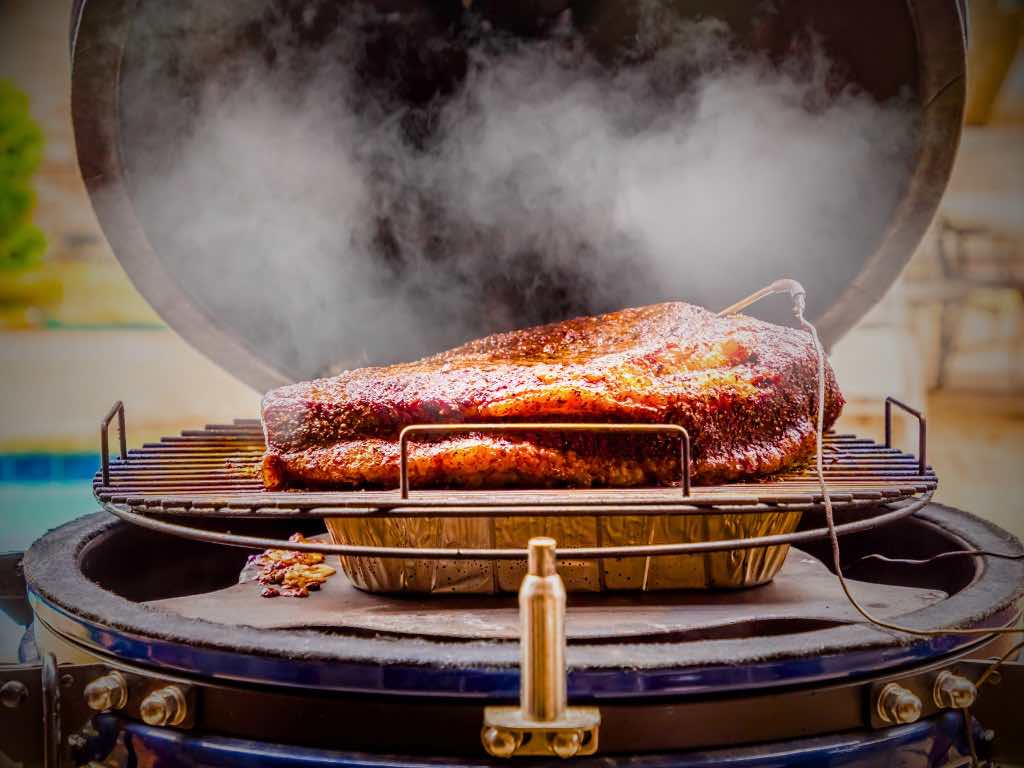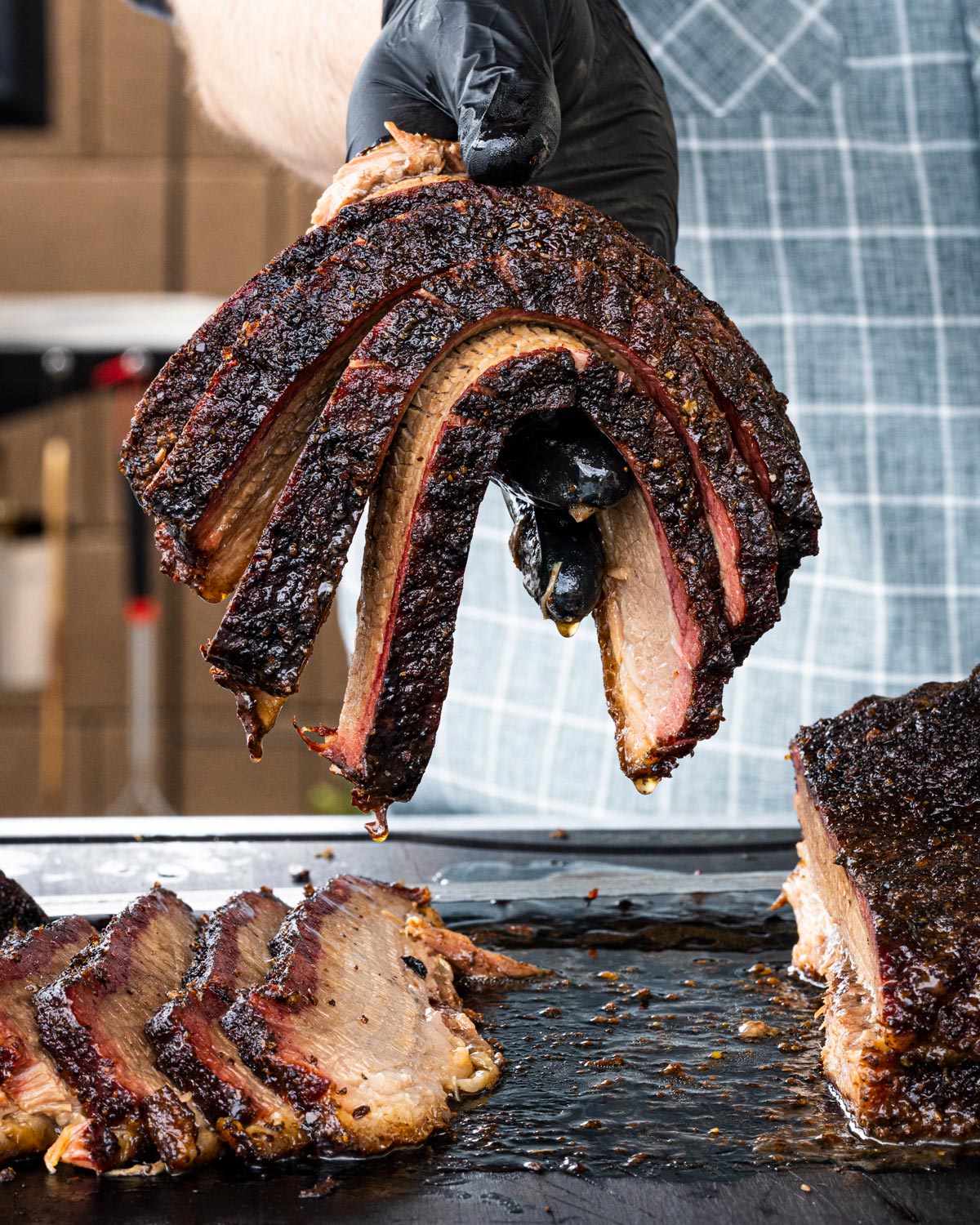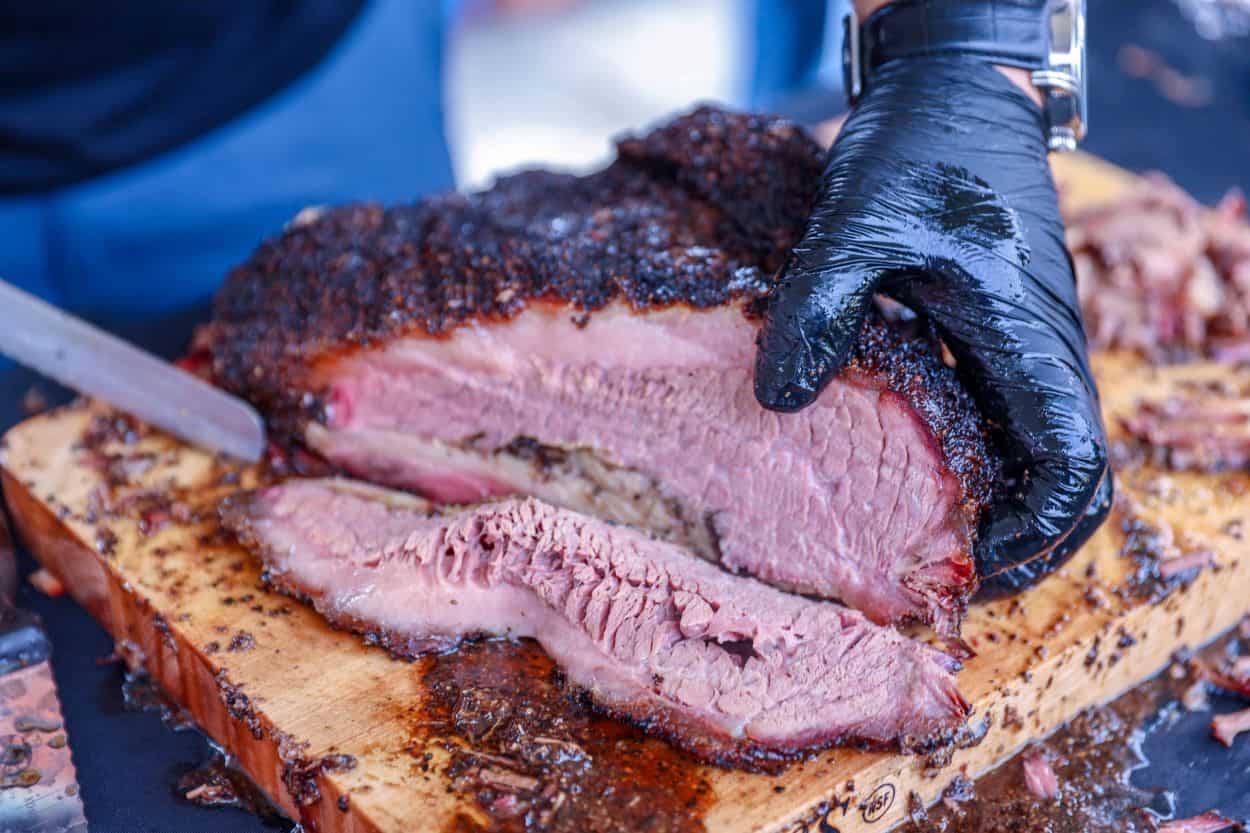Overview of Brisket Smoking
What is Brisket?
Brisket is a cut of meat that comes from the breast or lower chest of cattle. Due to its muscles being heavily exercised, brisket tends to be tough and contains a significant amount of connective tissue and fat. This is where the magic of smoking comes in. Through the cooking process, especially when paired with low temperatures and long cooking times, the collagen in brisket breaks down, transforming this once tough cut into a tantalizing, tender dish that is packed with flavor.
There are two primary sections of a brisket:
- Flat: This is the leaner portion that cooks evenly and is often where most of the meat slicing occurs.
- Point: This part is marbled with fat and is typically used for dishes like burnt ends, known for its rich flavor and tenderness.
Methods of Smoking Brisket
When it comes to smoking brisket, there are a couple of styles to choose from, each with its unique benefits and flavor profiles. Typically, aficionados use one of the following methods:
- Low and Slow:
- This traditional method cooks brisket at lower temperatures, around 225°F to 250°F (107°C to 121°C), for an extended time—often 12 to 18 hours.
- Ensures a deep flavor with rich bark formation and allows for complete tenderizing of the meat.
- Hot and Fast:
- This modern method involves cooking brisket at higher temperatures (around 350°F or 177°C), significantly reducing cook times to 6-7 hours.
- While it may sacrifice some of the traditional low-and-slow flavors, it still results in a delicious product when executed correctly.
Both methods can lead to mouthwatering results when done with care, patience, and the right tools. Whether it’s your first attempt at smoking brisket or you’re a seasoned pro looking to experiment, understanding these methods can enhance your BBQ repertoire.

The Science Behind Temperature
Importance of Temperature in Brisket Smoking
When it comes to smoking brisket, temperature serves as the cornerstone of successful cooking. Understanding how temperature affects brisket transforms this culinary endeavor from a daunting task to a rewarding experience. The key to perfecting brisket lies within the delicate balance of time and temperature.
- Ideal Range: Most pitmasters aim for an internal temperature of 195°F to 205°F (90°C to 96°C), which is considered the sweet spot for brisket. At this range, the collagen breaks down into gelatin, resulting in a flavorful and tender masterpiece.
- Low and Slow: Cooking brisket at low temperatures (around 225°F to 250°F) allows for even cooking, permitting the tough muscle fibers to relax and transform. This method requires patience, often taking 10-18 hours, but the result is undeniably worth the wait.
The magic truly happens within this temperature zone, where tough cuts of meat turn into succulent bites that showcase the true essence of barbecue.
Effects of Temperature on Brisket Texture
The texture of brisket is a reflection of how well it has been cooked, and temperature plays a critical role in this.
- Under 195°F: Cooking below this threshold might leave the brisket tough and chewy. While safe to eat, it lacks that melt-in-your-mouth quality that we seek.
- Over 210°F: Going above this temperature can lead to dryness and stringy meat. At this point, the meat has usually exceeded the tenderizing effects of the heat, resulting in a less desirable mouthfeel.
- Stall Phenomenon: Understanding the stall (when the meat temperature plateaus) is also crucial. It typically occurs between 150°F to 180°F, as the evaporative cooling process takes place. This can be nerve-wracking for new cooks, but patience is vital. Once past the stall, the texture softens significantly, and the brisket can begin its transformation.
In conclusion, mastering the importance of temperature provides a foundation for creating mouthwatering brisket that impresses both family and friends. By diligently monitoring and responding to the brisket’s cooking temperature, anyone can elevate their barbecue game.

Finding the Perfect Temperature
Factors Influencing Temperature Choice
When it comes to smoking brisket, achieving the perfect temperature is key to getting that tender, melt-in-your-mouth experience. However, several factors influence how and when to choose that ideal temperature:
- Type of Cut: The type of brisket you’re using—whether it’s a full packer or just the flat—can significantly affect cooking times and temperatures. A whole packer brisket generally requires more time compared to just the flat due to its size and composition.
- Cooking Method: Different smoking methods, like low and slow versus hot and fast, shift the temperature ranges necessary for optimal results. If you’re going low and slow (around 225°F to 250°F), a temperature around 195°F is ideal for pulling.
- Meat Quality: The grade of the brisket can play a crucial role as well. Higher quality briskets with more marbling will render fat better and may benefit from a slightly higher cooking temperature.
- Personal Preference: Ultimately, your preference plays a crucial role. Some folks enjoy a brisket pulled at 180°F for a firmer texture, while others might wait until it hits 200°F for maximum tenderness.
Optimal Temperature Ranges for Brisket
Finding the optimal temperature for brisket is often considered an art. Generally, the sweet spot sits between 195°F to 205°F. Here are a few insights to consider:
- 195°F: This is widely regarded as the ideal pulling point. It delivers the perfect balance of tenderness without overcooking.
- 200°F to 205°F: Some pitmasters prefer pulling at these higher temperatures. This often results in an incredibly tender texture but can risk drying if not monitored closely.
- 180°F: While pulling at this temperature is acceptable, it may yield a less tender result. If you choose this route, make sure to allow for sufficient resting time.
To ensure consistency in your results, keep a reliable meat thermometer handy. Familiarize yourself with different brisket cuts and how they respond to heat over time. Overall, achieving the ideal brisket temperature often involves a bit of experimentation—so don’t hesitate to try different methods until you find your perfect rhythm!

Temperature Monitoring Tools
Types of Thermometers for Brisket
To ensure that brisket is cooked to perfection, having the right thermometer can make all the difference. Here are some popular options that cater to various cooking styles:
- Instant-Read Thermometers: These are perfect for checking the doneness of brisket quickly. Just insert the probe into the thickest part of the meat, and within seconds, you’ll get an accurate temperature reading. This type is great for checking multiple spots during cooking, especially as the meat approaches your target temperature.
- Probe Thermometers: These are designed for continuous monitoring. You insert the probe into the brisket before cooking and connect it to a digital display outside the smoker. The advantage? You can monitor the internal temperature without opening the smoker, preventing heat loss. Brands like the ThermoWorks Signals BBQ Thermometer are favored for their reliability and ease of use.
- Wireless Meat Thermometers: For those who prefer a hands-off approach, wireless thermometers allow you to monitor the cooking process from a distance. Many models come with smartphone apps that alert you when your brisket has reached the desired temperature, allowing you to spend less time hovering around the grill.
Best Practices for Monitoring Temperature
Getting the temperature just right is crucial for brisket success. Here are best practices to follow:
- Insert at the Right Spot: Always place the thermometer probe into the thickest part of the flat or point. Avoid fat pockets or areas with bone to ensure an accurate reading.
- Stay Attentive: Keep a close eye on the temperature, especially as it approaches your target range (195°F to 205°F). The last few degrees can take longer.
- Use Alarms: Set alarms on your thermometer for the target temperature. This will alert you as it gets closer, allowing you to prepare for the wrapping or resting stages without the risk of overcooking.
- Resting Is Key: After reaching the ideal temperature, always allow your brisket to rest for at least 30 minutes before slicing. This helps the juices redistribute, resulting in a tender and flavorful cut.
By using temperature monitoring tools effectively and following best practices, even novice pitmasters can achieve mouthwatering brisket that impresses their guests. Happy smoking!
Adjusting Temperature during the Cook
When to Increase or Decrease Temperature
Controlling the temperature during the brisket cooking process is essential for achieving that perfect finish. Knowing when to adjust the heat can be the difference between a tough cut and a tender masterpiece. Here’s when to make those adjustments:
- When to Increase: If you notice that your brisket has stalled (typically between 150°F to 180°F), and the temperature has plateaued for an extended period, it may be time to increase the heat. A slight bump to around 275°F can help push through the stall more effectively.
- When to Decrease: On the other hand, if the internal temperature climbs significantly above your target range (over 205°F), it might be prudent to decrease the temperature. This can prevent overcooking and drying out the meat. Reducing the heat will help it cook evenly without turning into a chewy mess.
Adjusting your smoker can involve simple tweaks like opening the vent or adding or reducing fuel for indirect heat, allowing for a more controlled cooking environment.
Tips for Maintaining Consistent Heat Levels
Maintaining steady temperatures while smoking brisket is vital for consistent results. Here are some helpful tips:
- Check Fuel Levels: Ensure you have enough charcoal or wood before starting. Running out mid-cook can lead to temperature dips.
- Use a Water Pan: Incorporating a water pan in your smoker can help regulate temperature by adding moisture to the cooking environment. This assists with maintaining heat consistency and prevents over-drying the brisket.
- Don’t Open the Lid: As tempting as it might be to check on your brisket, frequently opening the lid can cause significant heat fluctuations. Resist the urge and leave it be until it’s time to wrap or check the internal temperature.
- Invest in Quality Thermometers: Using multiple probes, like those found in the Signals BBQ Thermometer, allows for remote monitoring of both the meat’s internal temperature and the smoker’s ambient heat. This makes it easier to maintain consistency without constant supervision.
By carefully adjusting and maintaining temperature levels, pitmasters can ensure a tender, flavorful brisket that is sure to impress. Happy smoking!
Resting and Serving Brisket
Importance of Resting Brisket
After all the hard work of smoking a brisket, the resting phase is crucial—akin to letting a musician take a deep breath before the big performance. This period allows the juices within the brisket to redistribute throughout the meat, leading to a tender and juicy final product.
- Juice Retention: When brisket is pulled directly off the heat and sliced immediately, those flavorful juices escape, resulting in dryer meat. A proper rest allows the meat fibers to relax and reabsorb those delicious liquids.
- Timeframe: It is generally recommended to let the brisket rest for at least 30 minutes, but some pitmasters suggest even up to 4 hours in a cooler for best results. This can enhance the flavor and texture, especially if you’re serving a larger gathering.
- Temperature Monitoring: During the resting phase, monitor the temperature if possible. Once the brisket cools to 140°F or slightly below, it can be kept in a controlled environment (such as a warming drawer) to maintain optimal serving temps.
Serving Brisket at the Right Temperature
Serving brisket at the right temperature is pivotal for showcasing its full potential. Here are some serving tips:
- Ideal Slicing Temperature: For the juiciest slices, aim to serve the brisket when it’s at a temperature between 140°F to 150°F. This ensures that it’s warm enough for optimal flavor without being overly hot, which can cause the juices to run when sliced.
- Presentation: When it comes to serving brisket, presentation matters! Slice against the grain to ensure tenderness. If the flat and point are separated, pay attention to the different grain directions to get the best results.
- Pairing: Don’t forget to complement your brisket with tasty sides. Classic pairings include pickles, coleslaw, and your favorite barbecue sauce.
Ultimately, allowing your brisket to rest and serving it at the right temperature elevates your BBQ game, leaving your guests wanting more. Enjoy the fruits of your labor—it’s time to dig in!

Leave a Reply